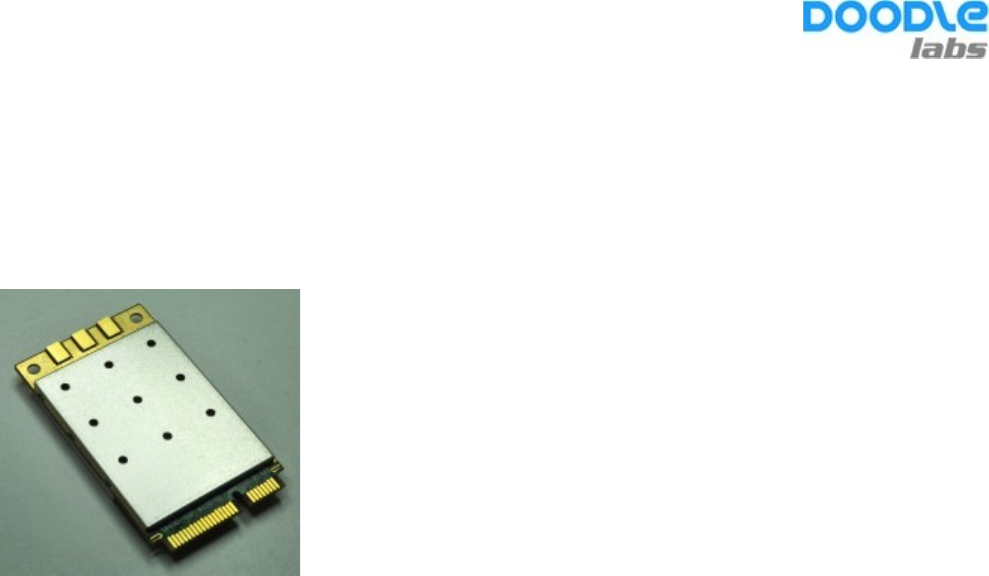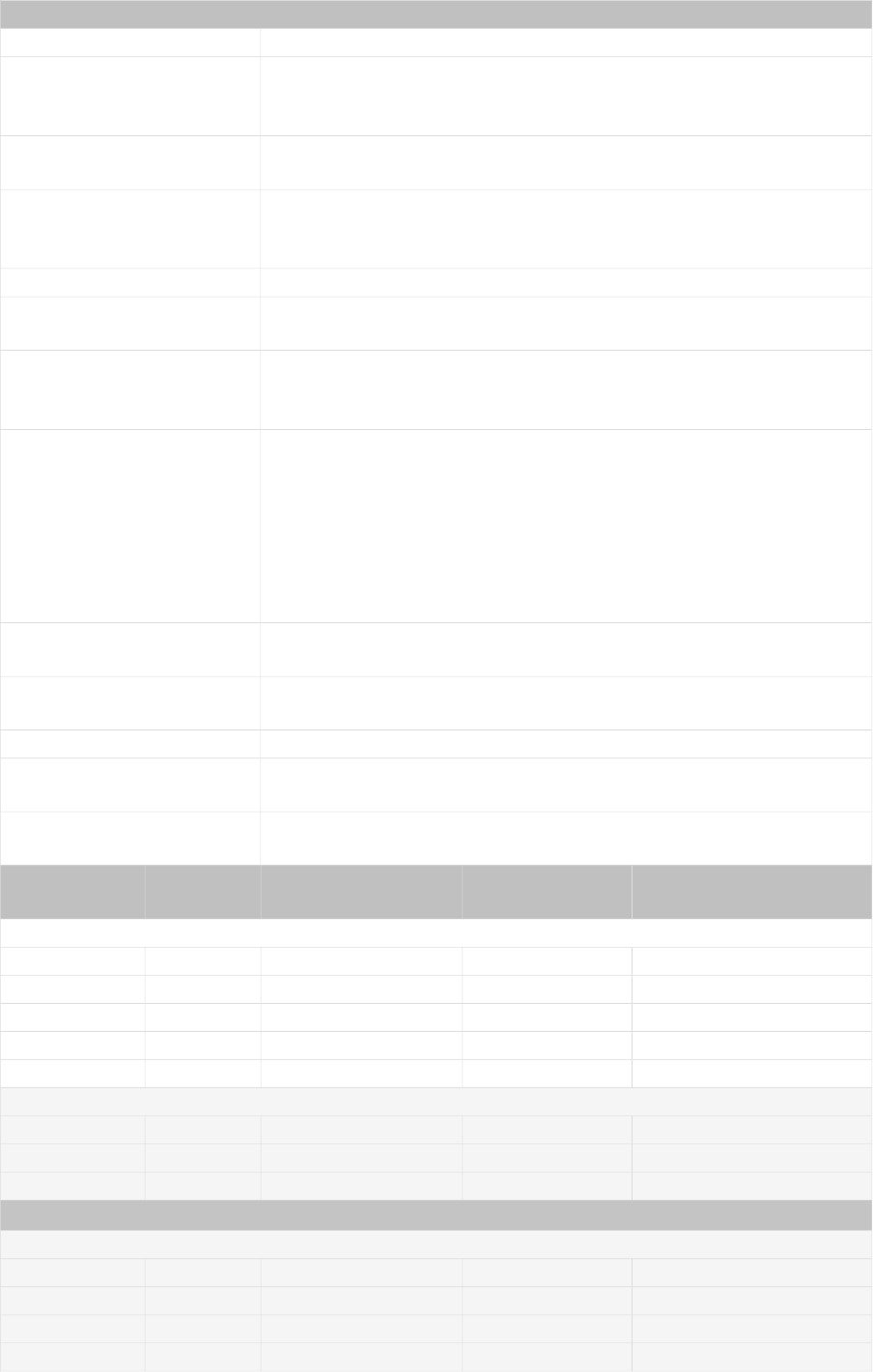Doodle Labs NM-DB-3N Wi-Fi Radio Transceiver User Manual
Doodle Labs (SG) Pte Ltd Wi-Fi Radio Transceiver
User Manual

NM-DB-3
Rugged/Military grade 2.4/5 GHz 3x3 MIMO Wi-Fi® Radio Transceivers
Features
Qualcomm-Atheros AR9590-AR1B Chipset with Extended Temperature Range
Up to 450 Mbps Throughput with 3x3 MIMO Technology
Calibrated High Power 2.4 GHz (29 dBm) and 5 GHz operation (27 dBm) for Extended Range
Supported Ath9k Linux Driver
MiniPCIE Interface
User Manual

TECHNICAL SPECIFICATIONS
Model No. NM-DB-3
MAC Chipset
Qualcomm Atheros
QCA9590-AR1B with Extended Temperature range for Outdoor and
Rugged models)
Software Support Linux Drivers
ath9k
Center Frequency Range
5.180 GHz -5.240 Ghz & 5.745 GHz -5.825 Ghz
2.412 GHz ~ 2.484 GHz
This varies by the regulatory domain
Channel Bandwidth* 20, 40 MHz channels
Radio Modulation (Dynamic
Link Adaptation)
BPSK, QPSK, 16 QAM, and 64 QAM (5.x GHz)
CCK, BPSK, QPSK, 16 QAM, and 64 QAM (2.4 GHz)
Data Rates Supported
802.11a: 6, 9, 12, 18, 24, 36, 48 and 54 Mbps (5.x GHz)
802.11n: MCS0-23 (5.x and 2.4 GHz)
802.11b/g: 1, 2, 5.5, 6, 9, 11, 12, 18, 24, 36, 48 and 54 Mbps (2.4 GHz)
802.11n version 2.0
Capabilities
802.11n and b/g Beam Forming
Packet aggregation: A-MPDU (Tx/Rx), A-MSDU (Tx/Rx), Maximal
ratio combining (MRC), Cyclic shift diversity (CSD), Frame
aggregation, block ACK, 802.11e compatible bursting, Spatial
multiplexing, cyclic-delay diversity (CDD), low-density parity check
(LDPC), Space Time Block Code (STBC)
Phy data rates up to 450 Mbps (40 MHz channel)
Operating Modes AP, STA and Adhoc modes to implement Point to Point, Point to multi
Point
MAC Protocol TDD with Carrier Sense Multiple Access with Collision Avoidance
(CSMA/CA)
Wireless Error Correction FEC, ARQ
Wireless Data Security 128 bit AES, WEP, TKIP and WAPI hardware encryption. Support for
IEEE 802.11d, e, h, i, k, r, v, w and time stamp standards
FIPS Certification Loop back mode to facilitate FIPS AES certification, Small packet size
(96 bytes) in AES encryption at full packet rate
Tx/Rx
Specification
Radio
Modulation Coding Rate Max Tx Power Rx Sensitivity
(Typ)
5 GHz (20 MHz Channel)
802.11a, STBC BPSK 1/2 25.18 -96
802.11a, STBC 64 QAM 3/4 25.09 -81
MIMO BPSK 1/2 25.09 -93
MIMO 16 QAM 3/4 25.09 -83
MIMO 64 QAM 5/6 25.09 -72
5 GHz (40 MHz Channel)
MIMO BPSK 1/2 22.93 -90
MIMO 16 QAM 3/4 22.93 -79
MIMO 64 QAM 5/6 22.93 -69
2.4 GHz (20 MHz Channel)
802.11b, STBC 1 Mbps CCK 27.32 -100
802.11g, STBC 64 QAM 3/4 27.16 -80
802.11n, MIMO BPSK 1/2 26.84 -92
802.11n, MIMO 16 QAM 3/4 26.84 -82

802.11n, MIMO 64 QAM 5/6 26.84 -72
2.4 GHz (40 MHz Channel)
802.11n, MIMO BPSK 1/2 26.94 -90
802.11n, MIMO 16 QAM 3/4 26.94 -79
802.11n, MIMO 64 QAM 5/6 26.94 -70
Note 1 It is advantageous to use the smallest Channel Bandwidth that can support the Throughput
requirements. Smaller bandwidths provide more channels to choose and help avoid interference
issues. The system’s SNR is higher at smaller Channel Bandwidths and Range is longer.
Note 2 Max allowed Tx power depends on the regulatory domain
Antenna Signal Strength -35 to -85 dBm (Recommended), Absolute Maximum=+12 dBm
Antenna port isolation for
concurrent operation
Up to +10 dBm signal strength for 5 GHz signal without degrading 2.4
GHz operation
Up to +5 dBm signal strength for 2.4 GHz signal without degrading 5.x
GHz operation
Integrated Antenna Port
Protection >20 KV (Human Body Model)
Receiver LNA Gain >10 dB
Receiver Adjacent Channel
Rejection (ACR) >18 dB @ 11a, 6 Mbps (Typ)
Receiver Alternate Channel
Rejection (ALCR) >35 dB @ 11a, 6 Mbps (Typ)
Receive chain Noise Figure +6 dB
Transmitter Adjacent Channel
Leakage power Ratio (ACLR) 45 dB (Fc ± ChBW)
Transmitter Spurious
Emission Suppression -40 dBc
RF Power control In 0.5 dBm steps. Accuracy of power calibration loop ±2 dBm. Each
transceiver individually calibrated and tested.
RF Hardware Disable (RF
Kill) Pin 20 of miniPCI-E interface. (Required for FAA compliance)
Control for External Power
Amp Available as an optional configuration
Spectral Analysis 8 bit resolution spectral FFTs available for software analysis
PHYSICAL, ENVIRONMENTAL AND OTHER SPECIFICATIONS
Antenna Ports 3 Ports (50 Ohms) with MMCX connectors.
Host Interface miniPCI-Express 1.2 Standard
Host CPU Board Any CPU board with Industry standard miniPCI-Express interface with
minimum 6 mm connector height
Operating Voltage 3.3 Volts from miniPCI-Express connector
Power Consumption
5.3W @ Max power, in continuous data transfer mode on all chains
3.75W @ 25 dBm power, in continuous data transfer mode on all
chains
2.5W @ 20 dBm power (ETSI max), in continuous data transfer mode
on all chains
0.9W in continuous data receive mode
250 mW in Sleep mode
Shield case temperature
range (Operating)
-40°C to +80°C
The System’s thermal design should ensure that the transceiver’s case
temperature is maintained within these specifications.
Humidity (Operating) 0% – 95% (Non-condensing)
Dimensions 30 x 50 x 7 mm, 14 grams

Mechanical drawing and 3D-CAD files available upon request
Regulatory Requirements
Designed and Verified to meet various regulatory requirements. Formal
testing and approval is required based on the Integrator’s particular
host platform and antenna type. The Integrator is also responsible for
obtaining all required regulatory approvals in target markets for the
finished product.
FCC ID 2AG87NM-DB-3N
CE/ETSI Q3 2016
Industry Canada (IC) Q3 2016
RoHS/WEEE Compliance Yes. 100% Recyclable/Biodegradable packaging

FCC Statement
Changes or modifications not expressly approved by the party responsible for compliance could void the user's authority to
operate the equipment.
This equipment has been tested and found to comply with the limits for a Class B digital device, pursuant to Part 15 of the FCC
Rules. These limits are designed to provide reasonable protection against harmful interference in a residential installation. This
equipment generates uses and can radiate radio frequency energy and, if not installed and used in accordance with the
instructions, may cause harmful interference to radio communications. However, there is no guarantee that interference will not
occur in a particular installation. If this equipment does cause harmful interference to radio or television reception, which can be
determined by turning the equipment off and on, the user is encouraged to try to correct the interference by one or more of the
following measures:
-- Reorient or relocate the receiving antenna.
-- Increase the separation between the equipment and receiver.
-- Connect the equipment into an outlet on a circuit different from that to which the receiver is connected.
-- Consult the dealer or an experienced radio/TV technician for help
This device complies with part 15 of the FCC rules. Operation is subject to the following two conditions (1)this device may not
cause harmful interference, and (2) this device must accept any interference received, including interference that may cause
undesired operation
Singapore: USA:
Doodle Labs (SG) Pte. Ltd. Doodle Labs LLC
150 Kampong Ampat 2 Mattawang Drive
KA Center, Suite 05-03 Somerset, NJ 08873
Singapore 368324 Tel: +1 862 345 6781
Tel: +65 6253 0100 Fax: +65 6353 5564
The antenna(s) used for this transmitter must be installed to provide a separation distance of at least 20 cm from all persons
and must not be collocated or operating in conjunction with any other antenna or transmitter, except in accordance with
FCC multi-transmitter product procedures.
Radiation Exposure Statement:
This equipment complies with FCC radiation exposure limits set forth for an uncontrolled environment.
This transmitter must not be collocated or operating in conjunction with any other antenna or transmitter.
The availability of some specific channels and/or operational frequency bands are country dependent and are
firmware programmed at the factory to match the intended destination.
The firmware setting is not accessible by the end user.
The modular can be installed or integrated in mobile or fix devices only.
This modular cannot be installed in any portable device, for example, USB dongle like transmitters is forbidden.
If the FCC identification number is not visible when the module is installed inside another device, then the outside
of the device into which the module is installed must also display a label referring to the enclosed module.
This exterior label can use wording such as the following: “Contains Transmitter Module FCC ID:2AG87NM-DB-3N
Or Contains FCC ID:2AG87NM-DB-3N” when the module is installed inside another device, the user manual
of this device must contain below warning statements;
1. This device complies with Part 15 of the FCC Rules. Operation is subject to the following two conditions:
(1) This device may not cause harmful interference.
(2) This device must accept any interference received, including interference that may cause undesired operation.
2. Changes or modifications not expressly approved by the party responsible for compliance could void the
user's authority to operate the equipment.
The devices must be installed and used in strict accordance with the manufacturer's instructions as
described in the user documentation that comes with the product.
The antenna type used is the reverse screw R-SMA antenna and the max antenna gain is 3dBi.
The diagram shows how to connect the modular with its intended antenna .
Modular Coaxial Line
(50 )
ΩAntenna